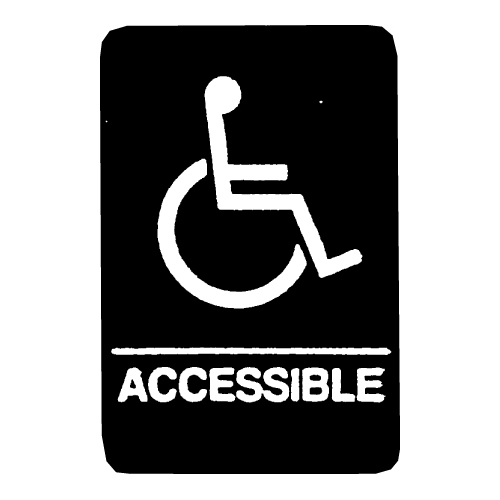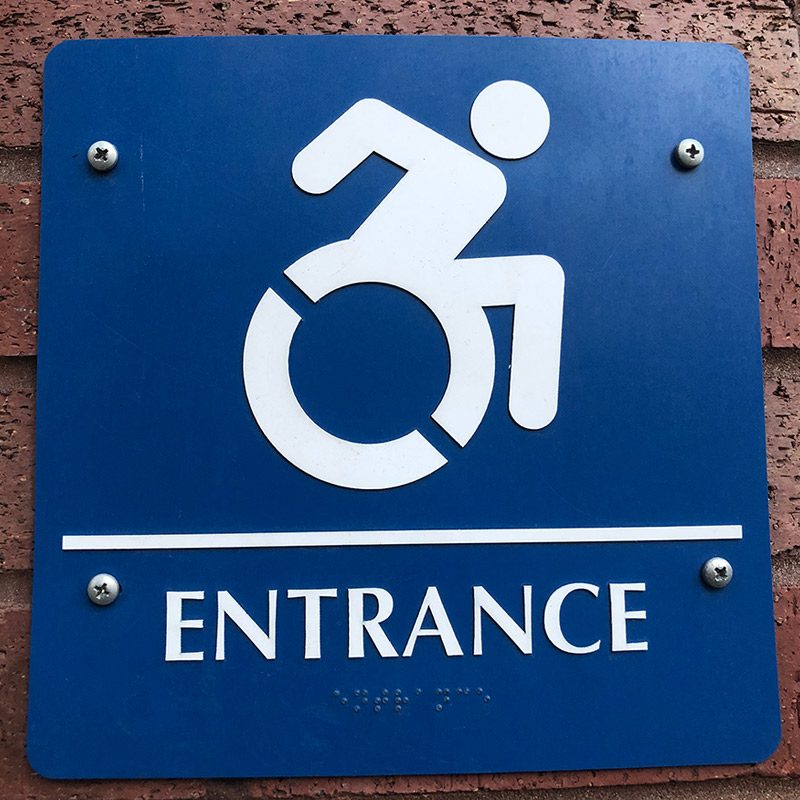The Impact of ADA Signs on Area Ease Of Access
The Impact of ADA Signs on Area Ease Of Access
Blog Article
Discovering the Key Functions of ADA Indicators for Boosted Accessibility
In the world of availability, ADA signs offer as silent yet effective allies, guaranteeing that spaces are comprehensive and navigable for people with impairments. By incorporating Braille and responsive components, these signs damage obstacles for the visually damaged, while high-contrast shade systems and clear font styles provide to varied visual needs.
Value of ADA Conformity
Making sure compliance with the Americans with Disabilities Act (ADA) is crucial for cultivating inclusivity and equal accessibility in public spaces and workplaces. The ADA, enacted in 1990, mandates that all public facilities, companies, and transport solutions accommodate individuals with specials needs, guaranteeing they delight in the exact same rights and chances as others. Conformity with ADA criteria not only fulfills legal responsibilities however additionally enhances an organization's track record by showing its commitment to diversity and inclusivity.
Among the key aspects of ADA compliance is the execution of easily accessible signage. ADA indications are made to ensure that people with impairments can easily browse through buildings and spaces. These signs must follow particular guidelines concerning size, font, color comparison, and positioning to assure exposure and readability for all. Correctly executed ADA signage aids remove barriers that people with disabilities frequently experience, thereby advertising their freedom and confidence (ADA Signs).
In addition, sticking to ADA policies can mitigate the danger of possible fines and lawful consequences. Organizations that stop working to abide with ADA guidelines might deal with penalties or legal actions, which can be both harmful and monetarily difficult to their public image. Therefore, ADA conformity is essential to fostering a fair environment for everyone.
Braille and Tactile Aspects
The unification of Braille and responsive elements into ADA signage embodies the principles of availability and inclusivity. It is typically placed below the matching text on signage to make sure that people can access the details without aesthetic assistance.
Responsive elements expand beyond Braille and consist of elevated signs and characters. These components are designed to be discernible by touch, permitting people to recognize area numbers, restrooms, leaves, and various other crucial areas. The ADA sets certain guidelines relating to the size, spacing, and positioning of these responsive aspects to optimize readability and ensure uniformity throughout different settings.

High-Contrast Color Pattern
High-contrast color plans play an essential role in boosting the visibility and readability of ADA signs for individuals with aesthetic impairments. These systems are necessary as they make best use of the distinction in light reflectance between message and background, making sure that signs are conveniently discernible, also from a range. The Americans with Disabilities Act (ADA) mandates using details color contrasts to suit those with limited vision, making it a critical element of conformity.
The effectiveness of high-contrast shades hinges on their capacity to stand out in different lighting conditions, important site consisting of dimly directory lit settings and areas with glow. Typically, dark message on a light background or light text on a dark history is employed to accomplish optimal comparison. Black message on a yellow or white background offers a plain aesthetic difference that assists in quick recognition and understanding.

Legible Fonts and Text Size
When taking into consideration the layout of ADA signs, the selection of legible fonts and suitable text size can not be overstated. These aspects are critical for ensuring that signs are available to people with aesthetic disabilities. The Americans with Disabilities Act (ADA) mandates that font styles have to be not italic and sans-serif, oblique, manuscript, very attractive, or of uncommon kind. These demands assist make sure that the text is quickly understandable from a range which the personalities are distinct to varied target markets.
The dimension of the message likewise plays a critical role in accessibility. According learn the facts here now to ADA guidelines, the minimal message height should be 5/8 inch, and it needs to raise proportionally with checking out distance. This is especially vital in public rooms where signage requirements to be reviewed swiftly and accurately. Uniformity in text dimension adds to a cohesive aesthetic experience, aiding people in navigating settings effectively.
In addition, spacing between lines and letters is essential to readability. Sufficient spacing prevents characters from showing up crowded, enhancing readability. By sticking to these criteria, designers can considerably boost ease of access, making certain that signage offers its intended function for all people, regardless of their aesthetic capabilities.
Reliable Positioning Methods
Strategic placement of ADA signage is necessary for optimizing ease of access and making certain compliance with lawful requirements. ADA standards specify that indicators must be installed at an elevation in between 48 to 60 inches from the ground to ensure they are within the line of sight for both standing and seated people.
In addition, indications must be placed surrounding to the lock side of doors to allow easy recognition prior to access. This placement helps people find rooms and spaces without obstruction. In situations where there is no door, indicators must be situated on the local nearby wall surface. Consistency in indicator placement throughout a facility improves predictability, reducing complication and enhancing total individual experience.

Verdict
ADA signs play a crucial duty in promoting ease of access by incorporating features that deal with the requirements of people with disabilities. Integrating Braille and responsive aspects makes sure crucial info is obtainable to the visually impaired, while high-contrast color design and clear sans-serif typefaces boost presence across different illumination conditions. Reliable positioning approaches, such as proper installing heights and calculated places, even more help with navigating. These components jointly promote an inclusive atmosphere, emphasizing the importance of ADA compliance in guaranteeing equal gain access to for all.
In the realm of access, ADA indications offer as silent yet powerful allies, ensuring that rooms are accessible and inclusive for individuals with disabilities. The ADA, enacted in 1990, mandates that all public centers, employers, and transportation solutions accommodate people with handicaps, ensuring they delight in the very same civil liberties and chances as others. ADA Signs. ADA signs are made to make sure that individuals with disabilities can conveniently browse through structures and rooms. ADA standards state that signs need to be installed at an elevation in between 48 to 60 inches from the ground to ensure they are within the line of view for both standing and seated people.ADA signs play a vital duty in advertising availability by integrating functions that address the demands of individuals with specials needs
Report this page